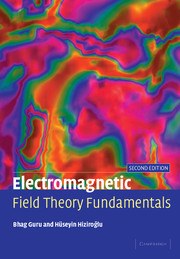Book contents
- Frontmatter
- Contents
- Preface
- Acknowledgments
- 1 Electromagnetic field theory
- 2 Vector analysis
- 3 Electrostatics
- 4 Steady electric currents
- 5 Magnetostatics
- 6 Applications of static fields
- 7 Time-varying electromagnetic fields
- 8 Plane wave propagation
- 9 Transmission lines
- 10 Waveguides and cavity resonators
- 11 Antennas
- 12 Computer-aided analysis of electromagnetic fields
- Appendix A Smith chart and its applications
- Appendix B Computer programs for various problems
- Appendix C Useful mathematical tables
- Index
11 - Antennas
Published online by Cambridge University Press: 05 June 2012
- Frontmatter
- Contents
- Preface
- Acknowledgments
- 1 Electromagnetic field theory
- 2 Vector analysis
- 3 Electrostatics
- 4 Steady electric currents
- 5 Magnetostatics
- 6 Applications of static fields
- 7 Time-varying electromagnetic fields
- 8 Plane wave propagation
- 9 Transmission lines
- 10 Waveguides and cavity resonators
- 11 Antennas
- 12 Computer-aided analysis of electromagnetic fields
- Appendix A Smith chart and its applications
- Appendix B Computer programs for various problems
- Appendix C Useful mathematical tables
- Index
Summary
Introduction
We now understand how fields propagate in an unbounded medium as plane waves and carry energy from one point to the other, how energy is transmitted along a transmission line, and how energy is channeled through a waveguide. We will now discuss systems that not only generate electromagnetic fields but also radiate them effectively.
Maxwell's equations dictate that in order to create electromagnetic fields we require time-varying sources such as charges and currents. When the fields created by these sources are confined to propagate as a wave along a transmission line or inside a waveguide, the wave is usually referred to as a guided wave. When these sources, finite in size, create waves that propagate away from them in an unbounded medium, they collectively form a radiating system, and the process is called the radiation of electromagnetic waves. The device at the end of a radiating system is referred to as a transmitting antenna (see Figure 11.1). A transmitting antenna, when fed by a transmission line as shown in Figure 11.2, is called a dipole antenna. Figure 11.3 shows a horn antenna fed by a waveguide. Among other types of antennas are a slot antenna (a slot in a large conducting plane fed by a waveguide), Figure 11.4, and a microstrip antenna (a thin patch of metal on a grounded dielectric substrate), Figure 11.5. When an antenna is used to capture the radiated energy, it is called a receiving antenna.
- Type
- Chapter
- Information
- Electromagnetic Field Theory Fundamentals , pp. 547 - 589Publisher: Cambridge University PressPrint publication year: 2004
- 1
- Cited by

